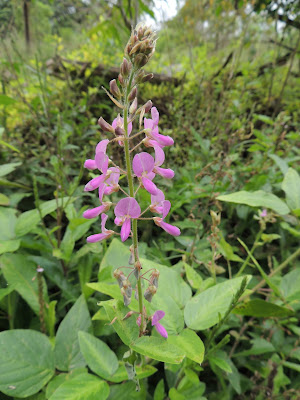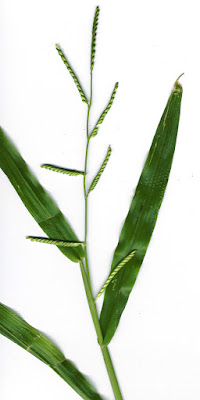Scarlet milkweed Asclepias curassavica, copyright Renjusplace.
Belongs within: Asclepiadoideae.
The Asclepiadeae are a clade of flowering plants supported by molecular phylogenetic analysis, defined by Sennblad & Bremer (2002) as the most expansive clade including
Asclepias and
Matelea but not members of the Fockeeae, Marsdenieae or Ceropegieae.
<==Asclepiadeae TGL-S08
|--Schizostephanus alatus SB02
|--+--Calotropis SB02
| | |--C. gigantea BB07
| | `--C. procera SB02
| | |--C. p. ssp. procera PP07
| | `--C. p. ssp. hamiltonii PP07
| `--Asclepias SB02
| |--A. albicans H93
| |--A. asperula [incl. A. capricornu ssp. occidentalis] H93
| |--A. californica H93
| |--A. cordifolia H93
| |--A. cornuti C55b
| |--A. cryptoceras [incl. A. cryptoceras ssp. davisii] H93
| |--A. curassavica SB02
| |--A. eriocarpa H93
| |--A. erosa H93
| |--A. fascicularis H93
| |--A. linaria H93
| |--A. nivea J87
| |--A. nyctaginifolia H93
| |--A. pubescens BR65
| |--A. rotundifolia Miller 1768 [incl. A. arborescens Linnaeus 1771, Gomphocarpus arborescens] BR65
| |--A. solanoana H93
| |--A. speciosa [incl. A. giffordii] H93
| |--A. subulata [incl. A. subulata var. parishii] H93
| |--A. syriaca W69
| |--A. tuberosa D51
| `--A. verticillata C01
`--+--+--+--Schubertia grandiflora TGL-S08
| | `--Araujia TGL-S08
| | |--A. hortorum SB02
| | `--A. sericofera TGL-S08
| `--Metastelmatinae G09
| |--Metastelma schaffneri TGL-S08
| `--Blepharodon G09
| |--B. ampliflorum G09
| |--B. crabronum Goyder 2009 G09
| |--B. lineare G09
| |--B. pictum G09
| `--B. salicinum G09
`--+--Cynanchum TGL-S08
| |--C. acutum AGF98
| |--C. carnosum LK14
| |--C. christineae LK14
| |--C. ellipticum TGL-S08
| |--C. floribundum BR65
| |--C. leptocladum J87
| |--C. leptolepis B00
| |--C. meyeri CV06
| |--C. ovalifolium B00
| |--C. pedunculatum VT13
| |--C. puberulum LK14
| |--C. utahense H93
| `--C. vincetoxicum BR65
`--+--Oxystelma bornouense TGL-S08
|--+--Pergularia daemia TGL-S08
| `--Gomphocarpus TGL-S08
| |--G. cancellatus B00
| |--G. fruticosus Br. 1809 C06 [=Asclepias fruticosa] BR65
| |--G. physocarpus TGL-S08 [=Asclepias physocarpa BR65]
| `--G. semiplectens CV06
`--Tylophora TGL-S08
|--T. benthamii LK14
|--T. cinerascens LK14
|--T. fleckii CV06
|--T. flexuosa LK14
|--T. heterophylla TGL-S08
|--T. flexuosa B12
`--T. sylvatica SB02
Asclepiadeae incertae sedis:
Microloma TGL-S08
|--M. hereroense CV06
|--M. penicillatum CV06
`--M. tenuifolium TGL-S08
Orthosia serpyllifolia SB02
Gonolobeae SB02
|--Fischeria stellata SB02
`--Matelea SB02
|--M. hirsuta SB02
`--M. parvifolia H93
Tweedia coerulea SB02
Vincetoxicum SB02
|--V. canescens C55a
`--V. hirundinaria SB02
*Type species of generic name indicated
REFERENCES
[AGF98] Abd El-Ghani, M. M., & A. G. Fahmy. 1998. Composition of and changes in the spontaneous flora of Feiran Oasis, S Sinai, Egypt, in the last 60 years.
Willdenowia 28: 123–134.
[BB07] Baishya, A. K., & P. J. Bora. 2007. Cross community ethno-medico botany of Dibru-Saikhowa Biosphere Reserve, Assam.
Bulletin of the Botanical Survey of India 49: 121–154.
[BR65] Black, J. M., & E. L. Robertson. 1965.
Flora of South Australia. Part IV. Oleaceae–Compositae. W. L. Hawes, Government Printer: Adelaide.
[B00] Braby, M. F. 2000.
Butterflies of Australia: their identification, biology and distribution vol. 2. CSIRO Publishing: Collingwood (Victoria).
[B12] Braby, M. F. 2012. The butterflies of El Questro Wilderness Park, with remarks on the taxonomy of the Kimberley fauna, Australia.
Records of the Western Australian Museum 27 (2): 161–175.
[C55a] Candolle, A. de. 1855a.
Géographie Botanique Raisonée: Ou exposition des faits principaux et des lois concernant la distribution géographique des plantes de l’époque actuelle vol. 1. Librairie de Victor Masson: Paris.
[C55b] Candolle, A. de. 1855b.
Géographie Botanique Raisonée: Ou exposition des faits principaux et des lois concernant la distribution géographique des plantes de l’époque actuelle vol. 2. Librairie de Victor Masson: Paris.
[C06] Cheeseman, T. F. 1906.
Manual of the New Zealand Flora. John Mackay, Government Printer: Wellington.
[C01] Cockerell, T. D. A. 1901. Contributions from the New Mexico Biological Station.—X. Observations on bees collected at Las Vegas, New Mexico, and in the adjacent mountains.
Annals and Magazine of Natural History, series 7, 7: 125–131.
[CV06] Craven, P., & P. Vorster. 2006. Patterns of plant diversity and endemism in Namibia.
Bothalia 36 (2): 175-189.
[D51] Dobzhansky, T. 1951.
Genetics and the Origin of Species 3
rd ed. Columbia University Press: New York.
[G09] Goyder, D. J. 2009.
Blepharodon crabronum (Apocynaceae: Asclepiadoideae), a new species from the pre-Cambrian serranias of eastern Bolivia.
Kew Bulletin 64 (1): 179–181.
[H93] Hickman, J. C. (ed.) 1993.
The Jepson Manual: Higher Plants of California. University of California Press: Berkeley (California).
[J87] Judd, W. S. 1987. Floristic study of Morne La Visite and Pic Macaya National Parks, Haiti.
Bulletin of the Florida State Museum—Biological Sciences 32 (1): 1–136.
[LK14] Lyons, M. N., G. J. Keighery, L. A. Gibson & T. Handasyde. 2014. Flora and vegetation communities of selected islands off the Kimberley coast of Western Australia.
Records of the Western Australian Museum Supplement 81: 205–244.
[PP07] Pandey, R. P., & P. M. Padhye. 2007. Studies on phytodiversity of Arid Machia Safari Park-Kailana in Jodhpur (Rajasthan).
Bulletin of the Botanical Survey of India 49: 15–78.
[SB02] Sennblad, B., & B. Bremer. 2002. Classification of Apocynaceae s.l. according to a new approach combining Linnaean and phylogenetic taxonomy.
Systematic Biology 51 (3): 389–409.
[TGL-S08] Thulin, M., D. Goyder & S. Liede-Schumann. 2008.
Cibirhiza spiculata (Apocynaceae), a remarkable new species from eastern Ethiopia.
Kew Bulletin 63 (4): 617–624.
[VT13] Vigilante, T., J. Toohey, A. Gorring, V. Blundell, T. Saunders, S. Mangolamara, K. George, J. Oobagooma, M. Waina, K. Morgan & K. Doohan. 2013. Island country: aboriginal connections, values and knowledge of the Western Australian Kimberley islands in the context of an island biological survey.
Records of the Western Australian Museum Supplement 81: 145–182.
[W69] Wiens, J. A. 1969. An approach to the study of ecological relationships among grassland birds.
Ornithological Monographs 8: 1–93.











